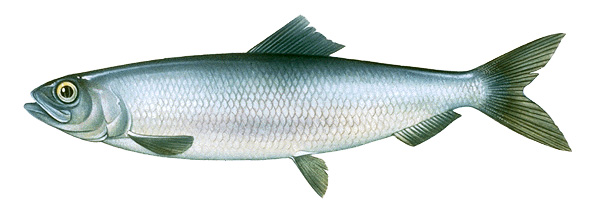Herring is the name of a large group of important food fish. These fish belong to the herring family, which also includes shad, menhaden, sardines, and alewives. The two most commercially important kinds of herring are the Atlantic herring and Pacific herring. Atlantic herring live along the seacoasts of the North Atlantic Ocean, as well as parts of the Arctic Ocean. Pacific herring inhabit coastal waters of the North Pacific and Arctic oceans. Populations of this species also occur in freshwater lakes in Japan.

Appearance and habits.
Atlantic herring and Pacific herring each have thin scales colored bluish to greenish-blue on the back and silver below. Both species commonly grow about 10 inches (25 centimeters) in length. The diet of Atlantic herring consists mainly of tiny water animals called copapods. Pacific herring eat mostly crustaceans and small fish.
Herring swim close together in schools, inhabiting a range of depths from the surface to 660 feet (200 meters) deep. Such schools may contain millions of fish and cover several square miles or square kilometers in area. Pacific herring migrate to shallower coastal waters to lay their eggs, usually in seaweed or eelgrass. Atlantic herring often lay eggs farther from the shore on rocks, sand, or algae. Females of both species lay thousands of eggs, which hatch within a few weeks.
Herring have many enemies, and few eggs develop into adult herring. Crabs and such fish as haddock eat many of the eggs and young. The adult herring are fall prey to other creatures of the sea, such as whales and seals, and to gulls and other birds.
Commercial fishing.
Traditionally, fishing crews have found the great schools of herring, called shoals, by watching for the many sea birds that hover over the schools, and by the light, or luminescence, caused in the sea water by the swimming herring. Many boats now detect the schools by sonar, a device that uses sound to detect underwater objects.
People usually catch herring in large nets. A fishing crew goes to a spot where a large number of herring are seen, and lets an immense net out. The crew then rows along the edges of the net in small boats, and forces the mass of fish nearer the center. Then, the fishing boat approaches and many thousands of herring are raised in the net and thrown into the boat.
Norway, Canada, and Sweden rank as leading countries in the harvest of Atlantic herring. Russia and the United States have large annual catches of Pacific herring.
Uses.
In much of the world, herring remain a favorite food, either pickled, smoked, or eaten fresh. Herring which have been smoked but not salted are known in England as Yarmouth bloaters. Those similarly prepared, but also split and cleaned, are called kippered herring. They are canned in Scotland and Norway and sent to America, where they are one of the most popular forms of herring. Small herring are often put into tins and sold as whitebait. Pickled herring are put into brine, sometimes with onions and spices. They are sold either round or split. Round herring are salted whole. Split herring have the gills, heart, and other parts removed. In Japan, people salt and eat herring eggs.
Many herring are frozen and used for bait in the halibut and cod fisheries. Some manufacturers convert the fish into fertilizer. Others use oil extracted from herring to lubricate machinery and for other purposes.
